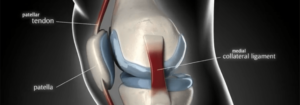 Injuries to the anterior cruciate ligament (ACL) are common among athletes in basketball, football, soccer, tennis and volleyball. This injury usually results when an individual makes a sudden stop to change direction.
Injuries to the anterior cruciate ligament (ACL) are common among athletes in basketball, football, soccer, tennis and volleyball. This injury usually results when an individual makes a sudden stop to change direction.
What is the ACL?
The ACL is a tough band of fiber in the middle of the knee joint. It connects the lower leg bone to the thigh bone. The ACL helps stabilize the knee during movement by keeping the lower leg bone from sliding too far forward. An injury to this ligament can make the knee unstable. The injury may be partly torn or a complete tear.
“Individuals who suffer an ACL injury usually have a lot of knee pain, swelling in their knee, difficulty with range of motion and a feeling of instability or ‘buckling,’” said Orthopedic Surgeon Dr. Megan Gleason.
An X-ray, MRI scan, or arthroscopy are usually required to diagnose an ACL tear. Ligament sprains are graded according to their severity:
- Grade 1—Mild ligament damage
- Grade 2—Partial tearing of the ligament
- Grade 3—Complete tearing of the ligament
Treatment Options
“When a patient comes to me with an ACL tear, we will first discuss their lifestyle and goals before deciding upon a treatment,” Dr. Gleason said. “Not every ACL tear need surgery. After assessing the patient’s goals for fitness and activity, I might suggest a non-operative treatment such as strengthening the knee through physical therapy and using a knee brace.”
If ACL-deficient patients want to get back into competitive sports or intense activities that require significant lateral or side-to-side movement, they risk damaging the meniscus, the cartilage, and other structures within the knee. Therefore, surgeons suggest ACL reconstruction for patients looking to get back to peak performance.
ACL Reconstruction
ACL reconstruction uses tissue from another part of the body to make a new ligament. It can take several months for the graft to become strong enough to return to sports.
“Unfortunately, we can’t just sew the ends of the ACL back together and have it reliably heal,” Dr. Gleason said. “The common technique is to take other tissues, usually your hamstring tissues or your patellar tendon, and use them to reconstruct the ACL within the knee.”
Recovery & Rehabilitation
After surgery, a physical therapist can test the knee movement and develop a recovery plan. Therapy can include exercise and stretching programs to help balance the muscles of your legs. This can help stabilize the knee and decrease the risk of further injury.
“The good news for people who experience an ACL tear is that surgery is very effective,” Dr. Gleason said. “It stabilizes the knee, and with the appropriate rehabilitation, patients can get back to 100% function. And it is also something that is not painful for the long-term.”
To see more of what Griffin Health can offer you, visit Sports medicine.